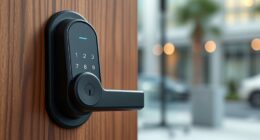Looking for the best vibration sensors to guarantee safe monitoring in 2025? I’ve found a variety perfect for industrial, home security, and DIY needs. From rugged industrial models like the WTVB01-485 to smart home options like Zigbee and WiFi sensors, there’s something for every scenario. Each offers adjustable sensitivity, easy installation, and reliable alerts. If you want to discover how these sensors can protect your environment, keep exploring—more options and insights await you.
Key Takeaways
- Consider sensors with adjustable sensitivity and multi-axis detection for accurate and reliable monitoring.
- Prioritize compatibility with existing smart home or industrial ecosystems like Zigbee, Z-Wave, or WiFi.
- Opt for durable, weatherproof models with easy mounting options for diverse environments.
- Evaluate power options (battery vs. wired) to ensure continuous operation and minimal maintenance.
- Choose sensors offering real-time data, low false alarms, and integration capabilities for comprehensive safety coverage.
RS485 Modbus Vibration Sensor (WTVB01-485)

If you’re looking for a durable, cost-effective vibration sensor for industrial condition monitoring, the RS485 Modbus Vibration Sensor (WTVB01-485) is a solid choice. It monitors 3-axis vibration data, including acceleration, angular velocity, displacement, speed, amplitude, and frequency, providing real-time measurements with ±5% accuracy. Its IP68 waterproof aluminum housing and impact resistance up to 20,000g make it suitable for tough environments. The device attaches magnetically (up to 70kg), and includes an RS-485 to USB converter for easy data collection. While its resolution is limited for high-precision needs, it’s ideal for troubleshooting, resonance detection, and large-area vibration analysis.
Best For: industrial maintenance teams and hobbyists seeking an affordable, durable vibration sensor for large-area monitoring and troubleshooting applications.
Pros:
- Robust IP68 waterproof aluminum housing suitable for harsh environments
- Easy magnetic attachment and inclusion of RS-485 to USB converter for straightforward data collection
- Capable of monitoring multiple vibration parameters in real-time, ideal for resonance and fault detection
Cons:
- Limited measurement resolution (integer-based velocity, no decimal precision) for high-accuracy needs
- Lack of detailed internal sensor specifications and calibration data, reducing reliability for critical tasks
- Documentation and software guidance are limited and sometimes difficult to access, posing setup challenges
THIRDREALITY Zigbee Vibration Sensor with Alarm

The THIRDREALITY Zigbee Vibration Sensor with Alarm is an excellent choice for homeowners seeking a versatile and easy-to-integrate monitoring solution. It uses Zigbee 3.0, making it compatible with popular hubs like SmartThings, Echo devices, and Home Assistant. The sensor detects vibrations from doors, windows, or furniture, with four adjustable sensitivity levels for customization. It features a loud 110dB siren and a manual mute switch for immediate alerts. Powered by batteries lasting around a year, it’s compact, discreet, and simple to install. While mostly reliable, some users report occasional disconnections or missed vibrations, which can be managed with sensitivity adjustments.
Best For: homeowners seeking an easy-to-install, customizable vibration sensor for security, appliance monitoring, or home automation routines.
Pros:
- Seamless Zigbee 3.0 compatibility with popular hubs like SmartThings, Echo, and Home Assistant
- Adjustable sensitivity levels for tailored detection of various objects and vibrations
- Loud 110dB siren with manual mute switch for immediate alerts and flexible control
Cons:
- Occasional disconnections or missed vibrations, especially with gentle or continuous motion
- Indoor-only rating limits outdoor or cold environment placement
- Manual sensitivity and alarm adjustments; lacks remote control options
BLE Vibration Sensor WTVB01-BT50 Smart Vibration Module for Arduino

For anyone developing Arduino-based projects that demand real-time vibration monitoring, the BLE Vibration Sensor WTVB01-BT50 stands out as an excellent choice. It offers thorough 3-axis vibration and temperature data, capturing displacement, velocity, and amplitude accurately from all directions. Its Bluetooth 5.0 connection supports wireless transmission up to 50 meters, with an 8-hour battery life and easy USB-C charging. The device’s compact design allows simple installation on various equipment, even in hard-to-reach spots. While the sensor provides reliable measurements for diagnostics and remote monitoring, users should note some software limitations and mounting challenges. Overall, it’s a versatile, cost-effective tool for professional vibration analysis.
Best For: professionals and hobbyists developing Arduino-based projects requiring accurate, wireless, real-time vibration and temperature monitoring in various equipment.
Pros:
- Offers comprehensive 3-axis vibration and temperature data with high accuracy and omnidirectional measurement.
- Wireless Bluetooth 5.0 connectivity with a range of up to 50 meters and easy USB-C charging.
- Compact, portable design with easy installation options, including strap holes and magnetic modifications.
Cons:
- Software and app limitations, including bugs on iOS and Android playback issues, hamper data analysis and user experience.
- Mounting sensors securely on vibrating machinery can be challenging, often requiring additional fixation methods.
- Limited measurement resolution (whole numbers only for velocity) reduces precision compared to professional standards.
Haozee Zigbee Vibration Sensor for Home Security

Looking for a reliable, discreet sensor to monitor vibrations and tilts around your home? The Haozee Zigbee Vibration Sensor is perfect. It detects vibrations and tilts in real time, sending quick alerts to keep your home secure. Compatible with platforms like Home Assistant and Zigbee2MQTT, it’s easy to integrate into your existing setup. Its small size allows hidden placement on doors, windows, or appliances. The sensor uses a built-in G-sensor for high sensitivity and adjustable settings to reduce false alarms. Quick to set up and dependable, it’s a smart choice for automating security and monitoring activities around your home.
Best For: homeowners and DIY enthusiasts seeking a discreet, reliable vibration and tilt sensor for home security and automation.
Pros:
- Supports popular platforms like Home Assistant and Zigbee2MQTT for easy integration
- Compact size allows discreet placement in tight or hidden spots
- Quick response time with real-time alerts enhances security monitoring
Cons:
- Shorter battery lifespan compared to larger AAA-based sensors
- Lacks physical controls, requiring app adjustments for sensitivity and settings
- Occasionally misses vibrations during certain activities, such as dryer cycles
WiFi Vibration Sensor for Window and Door Security

If you want reliable home or office security that detects even the slightest vibrations, the WiFi Vibration Sensor is an excellent choice. It connects seamlessly with the Tuya Smart Life App, providing real-time alerts whenever it detects vibrations on windows, doors, or equipment. Its high-sensitivity technology captures minor movements, and adjustable settings let you customize sensitivity for different environments. The sensor supports remote monitoring, so you can stay informed from anywhere. Compact and easy to install, it runs on long-lasting batteries, ensuring low maintenance. With smart integration, it can trigger alarms or lights automatically, enhancing your overall security system effortlessly.
Best For: homeowners and office managers seeking reliable, real-time vibration detection and smart security integration for windows, doors, and equipment.
Pros:
- High-sensitivity technology detects even minor vibrations for enhanced security
- Seamless integration with Tuya Smart Life App allows remote monitoring and automation
- Easy to install, compact design, and long-lasting battery life reduce maintenance
Cons:
- Requires compatible Tuya ecosystem devices for full automation capabilities
- Battery-powered operation may need periodic replacement or recharging
- Limited to vibration detection; does not include video or audio monitoring
Wireless Glass Break Detector with App Alerts (1-Pack)

The Wireless Glass Break Detector with App Alerts is an excellent choice for homeowners seeking a reliable, easy-to-install security device that can detect vibrations such as glass breaking or window tampering. It’s a wireless, WiFi-based sensor compatible with the Tuya Smart/Smart Life app, offering adjustable sensitivity and remote alerts. Installation is straightforward with adhesive or screws, making it suitable for windows, doors, garages, or pools. When vibrations are detected, it sends instant notifications to your phone. With smart linking options, it can trigger alarms or other devices, enhancing your home’s security. Its long battery life and history recording further improve peace of mind.
Best For: homeowners seeking an easy-to-install, WiFi-enabled vibration sensor for comprehensive home security and smart automation.
Pros:
- Easy installation with adhesive or screws, suitable for various surfaces and locations
- Compatible with the Tuya Smart/Smart Life app for remote monitoring and automation
- Long battery life with notifications for low voltage and activity history
Cons:
- Slightly slower response time (~3 seconds) compared to Zigbee sensors
- Limited cooldown adjustment, which may affect detection sensitivity and false alarms
- Requires stable 2.4 GHz WiFi connection, with potential setup challenges for some users
BLE Vibration Sensor WTVB01-BT50 Smart Vibration Module

Designed for professionals seeking reliable, real-time vibration monitoring, the WTVB01-BT50 BLE Vibration Sensor excels in capturing precise data from equipment operating in challenging environments. It measures 3-axis vibrations and temperature, providing detailed insights into displacement, velocity, and shock directions. Its omnidirectional detection guarantees accurate readings from all angles, helping prevent failures and reduce maintenance costs. Wireless with Bluetooth 5.0, it streams continuous telemetry data up to 50 meters and supports easy smartphone or PC integration. Despite some software limitations, its affordability, durability, and versatility make it suitable for diagnostics, robotics, and industrial applications, offering a practical solution for proactive equipment monitoring.
Best For: professionals and engineers seeking reliable, real-time vibration and temperature monitoring for machinery diagnostics, maintenance, and industrial applications.
Pros:
- Accurate 3-axis vibration and temperature data with omnidirectional detection
- Wireless Bluetooth 5.0 connectivity supporting up to 50 meters range
- Durable, compact design with easy installation options, including strap holes and magnetic modifications
Cons:
- Software and app limitations, including bugs and limited playback functionality
- Limited measurement resolution (whole number velocity, no decimal precision)
- Mounting and securing sensors can be challenging in vibrating environments
Zigbee Vibration Sensor for Smart Home Devices

For homeowners seeking reliable, real-time monitoring of vibrations and falls, the Zigbee Vibration Sensor offers an ideal solution. It works with a Tuya Zigbee Gateway and requires a Zigbee Hub to operate. When connected, it supports voice control via Alexa and Google Assistant. The sensor detects vibrations or falls, triggering immediate alerts and sending notifications to your smartphone through the Tuya Smart Life App. It also integrates seamlessly with other smart devices, enabling automation like opening curtains when vibration is detected. Plus, you can review historical activity logs anytime, giving you complete oversight of your home’s safety and activity.
Best For: homeowners seeking reliable, real-time vibration and fall detection with seamless smart home integration and remote monitoring capabilities.
Pros:
- Supports instant alerts and real-time notifications via Tuya Smart Life App.
- Integrates with other Tuya smart devices for automation, such as controlling curtains or lights.
- Records historical activity logs for easy review of vibration events and device performance.
Cons:
- Requires a Tuya Zigbee Gateway and Zigbee Hub, adding to setup complexity and cost.
- Shipped without batteries, meaning additional purchase and installation steps are necessary.
- Limited to compatible smart home ecosystems that support Tuya Zigbee devices, reducing flexibility with other platforms.
Vibration Sensor Detector with Alarm for Home and Office Monitoring

If you want a reliable way to monitor vibrations and receive instant alerts, this Vibration Sensor Detector with Alarm is an excellent choice for home and office security. Its compact, wall-mount design makes installation easy, and it works with ZigBee devices, offering a range of 10 to 30 meters. Powered by low-consumption AAA batteries, it updates status every 30 minutes and can trigger alarms or notifications in real-time. Perfect for various environments like greenhouses, workshops, or residential spaces, it provides dependable vibration detection in outdoor conditions, even in subfreezing temperatures. This sensor helps you stay informed and secure at all times.
Best For: homeowners, small business owners, and gardeners seeking reliable vibration alerts and automation for security, environmental monitoring, or greenhouse management.
Pros:
- Compact, wall-mountable design for easy installation in various environments
- Long-range ZigBee connectivity (10-30 meters) for flexible placement
- Low power consumption with battery operation and regular status updates
Cons:
- Limited to ZigBee-compatible systems, which may require additional hub setup
- Only updates status every 30 minutes, which may not suit real-time monitoring needs
- Some users report connectivity issues or compatibility challenges with certain platforms
Hiletgo SW-420 Vibration Sensor Module (5pcs)

The Hiletgo SW-420 vibration sensor modules are ideal for hobbyists and DIY enthusiasts seeking an affordable way to add vibration detection to their projects. Each of the five modules is compact, with a simple design featuring bolt holes for easy mounting, and operates on 3.3V to 5V. They produce a digital signal when vibration is detected, making them easy to integrate with microcontrollers like Arduino. However, sensitivity can be excessive, leading to false triggers, and some users report issues like the sensor sticking in a high state or bouncing signals. While great for basic tasks, they may not be suitable for applications demanding high reliability or precision.
Best For: DIY hobbyists and beginners looking for an inexpensive, easy-to-install vibration sensor for simple detection projects.
Pros:
- Compact size with mounting bolt holes for easy installation
- Compatible with Arduino and other microcontrollers for straightforward integration
- Cost-effective solution suitable for basic vibration detection tasks
Cons:
- Highly sensitive, prone to false triggers and noise
- Can get stuck in a high detection state, reducing reliability
- Difficult to fine-tune sensitivity, leading to inconsistent performance
5Pcs SW-420 Vibration Sensor Modules (Vibration Switch Alarm Sensors for Arduino)

Are you seeking an affordable, easy-to-integrate vibration sensor for your Arduino projects? The 5-piece SW-420 Vibration Sensor Modules are perfect for basic vibration detection. Each module features a normally closed sensor with a wide voltage range (3.3V to 5V) and a stable output thanks to the LM393 comparator. They produce a digital signal that triggers on vibration, and you can adjust sensitivity with a potentiometer to reduce false alarms. The compact design with mounting holes makes installation simple, whether on a breadboard or in a custom setup. These sensors are ideal for hobbyists and light-duty applications, offering straightforward vibration monitoring at an accessible price.
Best For: hobbyists and DIY enthusiasts seeking an affordable, easy-to-use vibration sensor for basic Arduino projects and light-duty monitoring tasks.
Pros:
- Affordable and available in a pack of 5 for multiple deployment options
- Compact size with mounting holes simplifies installation on various surfaces
- Adjustable sensitivity allows customization to reduce false triggers
Cons:
- Some users experience difficulty fine-tuning the sensitivity or false alarms
- Soldered pins can be challenging to remove or replace for modifications
- Designed primarily for hobbyist use, may lack the robustness needed for industrial applications
Piezoelectric Vibration Sensor Module

A piezoelectric vibration sensor module stands out for its ability to detect even minimal vibrations thanks to its sensitive ceramic piezoelectric sheets. When these sheets vibrate, they generate electrical signals proportional to the movement, making them highly responsive. I appreciate that the sensitivity can be adjusted, allowing me to fine-tune the sensor for specific needs—whether it’s detecting a light tap or a heavy impact. The module provides an analog output, which easily connects to controllers for real-time monitoring. Its durable, compact design makes it perfect for industrial environments and various applications, including security, smart home systems, and vehicle anti-theft setups.
Best For: hobbyists, engineers, and professionals seeking reliable vibration detection for industrial, security, or DIY projects.
Pros:
- Highly sensitive with adjustable levels to suit various detection needs
- Compact, durable design suitable for challenging environments
- Provides real-time analog output for easy integration with controllers
Cons:
- May require calibration for optimal sensitivity settings
- Analog output could be susceptible to noise in some environments
- Not suitable for detecting very high-frequency vibrations beyond its designed range
Glass Break Sensor 5 Pack for Home Security

If you’re looking for an affordable and easy-to-install solution to enhance your indoor security, the Glass Break Sensor 5 Pack by NOOPEL is an excellent choice. These compact sensors detect glass vibrations or shattering, triggering a loud 125dB siren and flashing LED to alert you instantly. They’re simple to mount with included double-sided tape, no wiring needed, and are suitable for windows, doors, and glass surfaces in homes, offices, or garages. Powered by batteries, they offer adjustable sensitivity to prevent false alarms. Overall, they provide a reliable, budget-friendly way to deter intruders and increase safety for your family or property.
Best For: homeowners, renters, or property managers seeking an affordable, easy-to-install indoor security solution to alert them of glass breakage or vibrations.
Pros:
- Easy peel-and-stick installation with no wiring or screws needed
- Loud 125dB siren effectively alerts residents and deters intruders
- Adjustable sensitivity helps prevent false alarms and suits various environments
Cons:
- Some units may experience functionality issues or false triggers
- Limited to indoor use; not suitable for outdoor security
- Battery replacement required over time, and low battery indicator may not be highly noticeable
Walfront Digital Vibration Meter and Vibrometer

The Walfront Digital Vibration Meter and Vibrometer stands out as an excellent choice for professionals needing accurate, real-time vibration measurements across various industries. Its split-type design and LCD display make it easy to use and read in different environments. It measures vibration speed, acceleration, displacement, and temperature, with a wide acceleration range of 0.1–199.9 m/peak. Powered without batteries, it uses a piezoelectric transducer for precise analysis. Compact and lightweight, it’s perfect for mechanical manufacturing, aerospace, and power sectors. With an average rating of 4.4 stars, it offers reliable performance, though some users note it may miss very small vibrations.
Best For: professionals in mechanical manufacturing, aerospace, electric power, and industrial sectors seeking accurate, real-time vibration and temperature measurements.
Pros:
- Wide measurement range for vibration speed (0.1–199.9 m/peak) and temperature in ℃ and ℉
- Compact, split-type design with LCD display for easy reading in various environments
- No batteries required, simplifying operation and maintenance
Cons:
- May not detect very small vibrations perceptible by hand
- Limited to conventional mechanical equipment vibrations, less effective for ultra-sensitive measurements
- Slightly higher price point compared to simpler vibration meters
Zigbee Smart Vibration Sensor with Tuya Smart Life App Notifications

For homeowners seeking reliable smart home security, the Zigbee Smart Vibration Sensor with Tuya Smart Life App notifications offers an excellent solution. It detects motion, vibration, and drops, sending instant alerts through the app. Compatible with other Tuya devices, it enables automation like turning on lights or opening curtains when triggered. The sensor uses ZigBee 3.0, with a 10-30 meter range indoors, and requires a ZigBee gateway for remote access via 3G, 4G, or WiFi. Easy to install with tape or screws, it features adjustable sensitivity, low battery reminders, and supports real-time push notifications, enhancing your home’s safety and automation.
Best For: homeowners seeking reliable, easy-to-install smart home security and automation solutions that can send instant alerts and integrate with existing Tuya-compatible devices.
Pros:
- Supports ZigBee 3.0 for stable, long-range communication within indoor environments
- Adjustable sensitivity and real-time push notifications enhance safety and customization
- Easy installation via tape or screws, with low power consumption ensuring long battery life
Cons:
- Requires a ZigBee gateway for remote control and automation, adding to initial setup cost
- Batteries are not included, necessitating separate purchase and replacement
- Slight color variations may occur due to lighting and display differences, with minor measurement errors
Factors to Consider When Choosing a Vibration Sensor for Safe Monitoring

When selecting a vibration sensor, I focus on factors like detection range and sensitivity to guarantee accurate monitoring. I also check if it’s compatible with my existing systems and consider power options for reliable operation. Additionally, ease of installation and measurement accuracy are essential for effective, safe monitoring.
Detection Range and Sensitivity
Choosing the right vibration sensor depends heavily on understanding its detection range and sensitivity, as these factors determine how effectively it can monitor vibrations without producing false alarms. Detection range varies from about 0.5 meters to over 30 meters, depending on the sensor technology and environment. Sensitivity can often be adjusted manually or through software, allowing you to detect minor or major vibrations. Higher sensitivity helps catch small vibrations but also increases the risk of false triggers caused by environmental noise. Keep in mind, the detection range may decrease in cluttered or noisy environments, especially with obstacles or electromagnetic interference. Selecting a sensor with appropriate range and sensitivity ensures reliable monitoring, minimizing missed vibrations and false alarms, which is vital for maintaining safety.
Compatibility With Systems
Selecting a vibration sensor that integrates smoothly with your existing systems can considerably impact monitoring effectiveness. I always check if the sensor supports your current protocols like Zigbee, Z-Wave, Bluetooth, WiFi, or Modbus to guarantee seamless communication. It’s important to verify compatibility with your smart hub or control platform, such as SmartThings, Home Assistant, or Alexa, so you can manage everything centrally. Also, confirm that the sensor’s communication interface aligns with your network setup, including frequency bands and ports. I look for sensors with compatible apps, SDKs, or APIs for easy data access and customization. Finally, I ensure the sensor works with your power sources—battery or wired—and supports firmware updates, keeping the system flexible and future-proof.
Power Supply Options
The power supply you choose for a vibration sensor plays a crucial role in its deployment and ongoing performance. Battery-powered sensors are portable and easy to install, making them ideal for quick setups or hard-to-reach areas. However, they require regular recharging or battery replacement, which can increase maintenance over time. Wired power options provide continuous operation without the need for frequent attention, but installing power lines can be complex and limit placement choices. Rechargeable batteries offer a middle ground, reducing long-term costs but depend on reliable charging routines and battery lifespan. When selecting a power source, consider the sensor’s energy consumption, the environment’s accessibility, and your maintenance capacity to ensure consistent, reliable monitoring without interruptions.
Installation Ease
When installing a vibration sensor, ease of setup can substantially impact the overall success of your monitoring system. I recommend choosing models with simple mounting options like adhesive or screw-in fixtures, which save time and guarantee a secure fit. Look for sensors with clear wiring diagrams or wireless connectivity to minimize technical errors during installation. Physical adjustment controls, such as sensitivity switches or potentiometers, allow you to fine-tune the sensor without needing software updates, making setup more straightforward. Additionally, thorough installation guides or user manuals are invaluable for correct placement and positioning. For outdoor installations, prioritize sensors with durable, weatherproof enclosures to reduce maintenance and prevent repositioning. Keeping installation simple ensures a smoother setup process and more reliable monitoring results.
Measurement Accuracy
Ensuring measurement accuracy starts with choosing a vibration sensor that delivers high-resolution data, often with decimal points like 0.0–49.99 mm/sec, to meet industry standards such as ISO 10816. The sensor’s measurement range must align with your application, capturing expected vibration amplitudes without saturation or losing detail. Verifying calibration data and internal specifications is vital for consistent, reliable readings over time. Low noise levels and high signal-to-noise ratios enhance data fidelity, reducing false alarms and improving detection accuracy. Regular calibration and validation against known standards are essential to maintain measurement precision. By focusing on these factors, you ensure your vibration sensor provides trustworthy data, enabling timely and accurate safety assessments in your monitoring system.
Environmental Durability
Choosing a vibration sensor that can withstand harsh environmental conditions is essential for reliable monitoring. I look for sensors with an IP68 or higher waterproof rating to guarantee they resist rain, dust, and other elements. An extended operating temperature range, from -20°C to 60°C or more, is vital for outdoor applications experiencing extreme weather. I prefer sensors made from durable, corrosion-resistant materials like stainless steel or high-quality plastics, which endure exposure to UV radiation and chemicals. Proper sealing and rugged design are crucial to minimize damage risks, reducing maintenance costs over time. These features ensure the sensor maintains accuracy and functionality despite environmental challenges, giving me confidence in long-term, safe monitoring without frequent replacements or repairs.
Data Connectivity Methods
Selecting the right vibration sensor involves considering how it will transmit data reliably in your monitoring environment. Different connectivity options suit various needs. WiFi sensors support real-time data streaming over local networks and the internet, ideal for remote monitoring. Bluetooth sensors are best for short-range applications, up to 50 meters, and often require pairing with smartphones or computers. Zigbee and Z-Wave sensors form mesh networks, offering low power consumption and dependable data transfer over moderate distances, typically around 30 meters indoors. RS-485 Modbus sensors use serial communication protocols, making them suitable for industrial environments where high reliability over longer distances is essential. Your choice should match your environment’s range, data speed requirements, and integration needs to guarantee continuous, accurate monitoring.
Calibration and Maintenance
Regular calibration is vital to keep vibration sensors accurate, especially in industrial or safety-critical applications. Many sensors lack built-in calibration features, so external calibration procedures or reference standards are often necessary. Maintenance involves more than calibration; it includes periodic cleaning, inspecting for physical damage, and verifying alignment to prevent false alarms. Sensor drift over time can compromise measurement accuracy, making scheduled recalibration or testing crucial for long-term reliability. Proper maintenance and calibration protocols not only ensure dependable monitoring but also extend the sensor’s lifespan. When selecting a vibration sensor, consider how easily it can be calibrated and maintained. Sensors with straightforward calibration procedures and clear maintenance requirements are better suited to guarantee consistent performance and safety over time.
Frequently Asked Questions
How Do Vibration Sensors Differentiate Between Normal and Suspicious Activity?
Vibration sensors differentiate between normal and suspicious activity by analyzing patterns and intensities of vibrations. I program them to recognize typical background vibrations, so when unusual patterns or higher amplitudes occur, they flag these as suspicious. These sensors use algorithms and thresholds to continuously monitor, ensuring I get real-time alerts for any abnormal activity. This way, I can respond quickly and maintain safety effectively.
What Is the Typical Lifespan of These Vibration Sensors in Harsh Environments?
The typical lifespan of vibration sensors in harsh environments usually ranges from 3 to 7 years, depending on factors like temperature, humidity, and exposure to chemicals. I’ve seen sensors last longer when properly maintained and installed correctly. Regular inspections and protective enclosures can considerably extend their life. If you’re planning for long-term monitoring, I recommend choosing sensors designed specifically for tough conditions and scheduling routine maintenance.
Are Vibration Sensors Compatible With Existing Home Security Systems?
Yes, vibration sensors can be compatible with existing home security systems. I’ve found that many modern sensors offer wireless connectivity, easy integration with smart home hubs, and customizable alerts. They work seamlessly alongside motion detectors, cameras, and alarms. To guarantee compatibility, I recommend checking the sensor’s specifications and your security system’s compatibility list. This way, you get a smooth setup and reliable, extensive protection for your home.
How Do Sensor Placement and Orientation Impact Detection Accuracy?
Sensor placement and orientation are vital for detection accuracy. I make sure to position sensors on stable surfaces where vibrations are most likely to occur, avoiding areas with lots of background noise. I also angle them correctly to cover the desired zones, ensuring they pick up relevant signals without false alarms. Proper placement and orientation help me reliably monitor activity and prevent potential security breaches.
What Are the Maintenance Requirements for Long-Term Reliable Operation?
Did you know that proper maintenance can extend a vibration sensor’s lifespan by up to 30%? I recommend regularly inspecting sensors for dust, corrosion, and loose connections. Calibration should be done at least annually to ensure accuracy. Additionally, keep software updated and replace worn components promptly. This proactive approach guarantees reliable performance, minimizes downtime, and keeps your monitoring system operating at peak efficiency over the long term.
Conclusion
Choosing the right vibration sensor is like finding the perfect alarm system—each has its strengths, but the best one fits your specific needs. I once installed a sensor that caught a minor tremor early, preventing costly damage. Remember, a good sensor acts like a vigilant guardian, alerting you before small issues become big problems. With the right choice, you’ll have peace of mind, knowing your safety is always on high alert.









